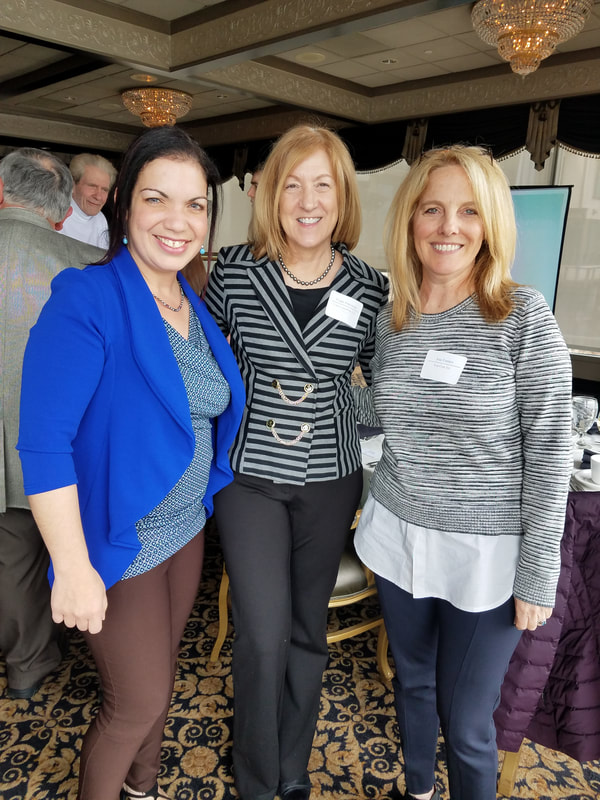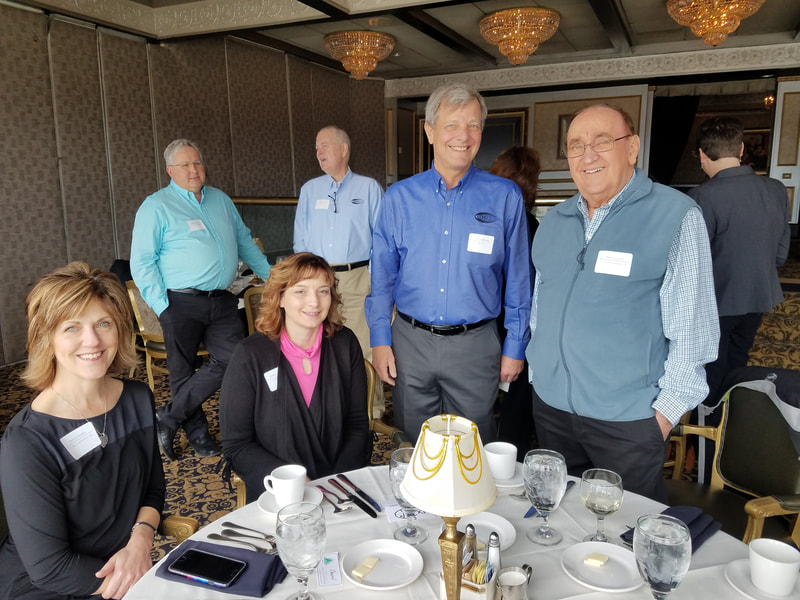Submitted by Pittsburgh AIHA Secretary, Frank J. Pokrywka, Ed.D, CIH

Please join me in thanking our National AIHA President, Cindy Ostrowski, for taking time out her busy schedule to meet with the Pittsburgh Local Section on March 28th at the LeMont Restaurant. This was the first time in several years that we were actually able to showcase our city from Mt. Washington without fog, rain or snow obstructing the view. Hailing from Detroit, Cindy is a Certified Industrial Hygienist (CIH) and AIHA Fellow, who established her own consulting firm, CAO Consulting, LLC after leaving a regional insurance company. She has over thirty years’ experience in the field of industrial hygiene conducting comprehensive surveys to evaluate employee exposures to occupational hazards. Prior to her career as an industrial hygienist, she was a registered medical technologist and practiced as a microbiologist in a clinical laboratory.
She holds a Master of Science degree in occupational and environmental health from Wayne State University and has taught health and safety courses as an assistant professor for Wayne State University and an adjunct professor at the University of Michigan. Prior to taking over as AIHA president, Cindy has served as Treasurer (2013-2016), Secretary (2008-2011) and a Board of Directors (2004-2007) for the AIHA. She is also the chair for the Industrial Hygiene Division, a board member and member of the scholarship committee for the Michigan Safety
Conference.
Before giving us the National AIHA “state of the union”, Cindy provided a technical presentation entitled “A Field Practitioner’s Collaborations to Produce the Best Sampling Results”. In it she compared traditional IH sampling methods with the current trend towards direct reading instruments. Evolving technology and innovations in sampling are rapidly changing the way industrial hygiene is practiced. Sensor technology, which can enable real time monitoring, sampling and job analysis, has the potential to change if and how laboratory testing is conducted. All field practitioners (whether using new or traditional sampling methods) need to better understand and appreciate the testing laboratory’s role in producing exposure data. Field practitioners should always be aware of the quality control, instrumentation, methods and accreditation requirements involved in analytical testing. In addition laboratory specialists need to better understand the work conducted by field practitioners. Her presentation focused on the importance of collaboration between field practitioners and testing laboratories in producing valid and defensible IH data.
The AIHA in 2019 has a new Strategic Plan along with updated Mission and Vision statements that can be found on the Local Section and National websites. In the new Plan are outlined six classes of AIHA membership including recent additions for New, Emeritus and International Members. Cindy also discussed new or expanded ways members can communicate online with fellow IHs via the Synergist and Catalyst websites. Also discussed were several AIHA programs available to Local Section members such as the Leadership Workshops, various publications, and automated election balloting and general liability insurance. Cindy touched on a few programs no longer supported by the AIHA including the Fall Professional Conference and the Local Section Council. Cindy urged all local section members to become more involved in their profession by joining one or more of the AIHA’s technical committees, volunteer groups or, if able, becoming active with another affiliate organizations committed to occupational health and safety at home or abroad. Local Section members can remain in communication with our National Headquarters via one of the social networks including Facebook, Twitter, In-Sync or You-Tube.
Both Cindy’s PowerPoint presentations on IH sampling and lab analysis and happenings at the National AIHA are available below:
Conference.
Before giving us the National AIHA “state of the union”, Cindy provided a technical presentation entitled “A Field Practitioner’s Collaborations to Produce the Best Sampling Results”. In it she compared traditional IH sampling methods with the current trend towards direct reading instruments. Evolving technology and innovations in sampling are rapidly changing the way industrial hygiene is practiced. Sensor technology, which can enable real time monitoring, sampling and job analysis, has the potential to change if and how laboratory testing is conducted. All field practitioners (whether using new or traditional sampling methods) need to better understand and appreciate the testing laboratory’s role in producing exposure data. Field practitioners should always be aware of the quality control, instrumentation, methods and accreditation requirements involved in analytical testing. In addition laboratory specialists need to better understand the work conducted by field practitioners. Her presentation focused on the importance of collaboration between field practitioners and testing laboratories in producing valid and defensible IH data.
The AIHA in 2019 has a new Strategic Plan along with updated Mission and Vision statements that can be found on the Local Section and National websites. In the new Plan are outlined six classes of AIHA membership including recent additions for New, Emeritus and International Members. Cindy also discussed new or expanded ways members can communicate online with fellow IHs via the Synergist and Catalyst websites. Also discussed were several AIHA programs available to Local Section members such as the Leadership Workshops, various publications, and automated election balloting and general liability insurance. Cindy touched on a few programs no longer supported by the AIHA including the Fall Professional Conference and the Local Section Council. Cindy urged all local section members to become more involved in their profession by joining one or more of the AIHA’s technical committees, volunteer groups or, if able, becoming active with another affiliate organizations committed to occupational health and safety at home or abroad. Local Section members can remain in communication with our National Headquarters via one of the social networks including Facebook, Twitter, In-Sync or You-Tube.
Both Cindy’s PowerPoint presentations on IH sampling and lab analysis and happenings at the National AIHA are available below:
|
| ||||







